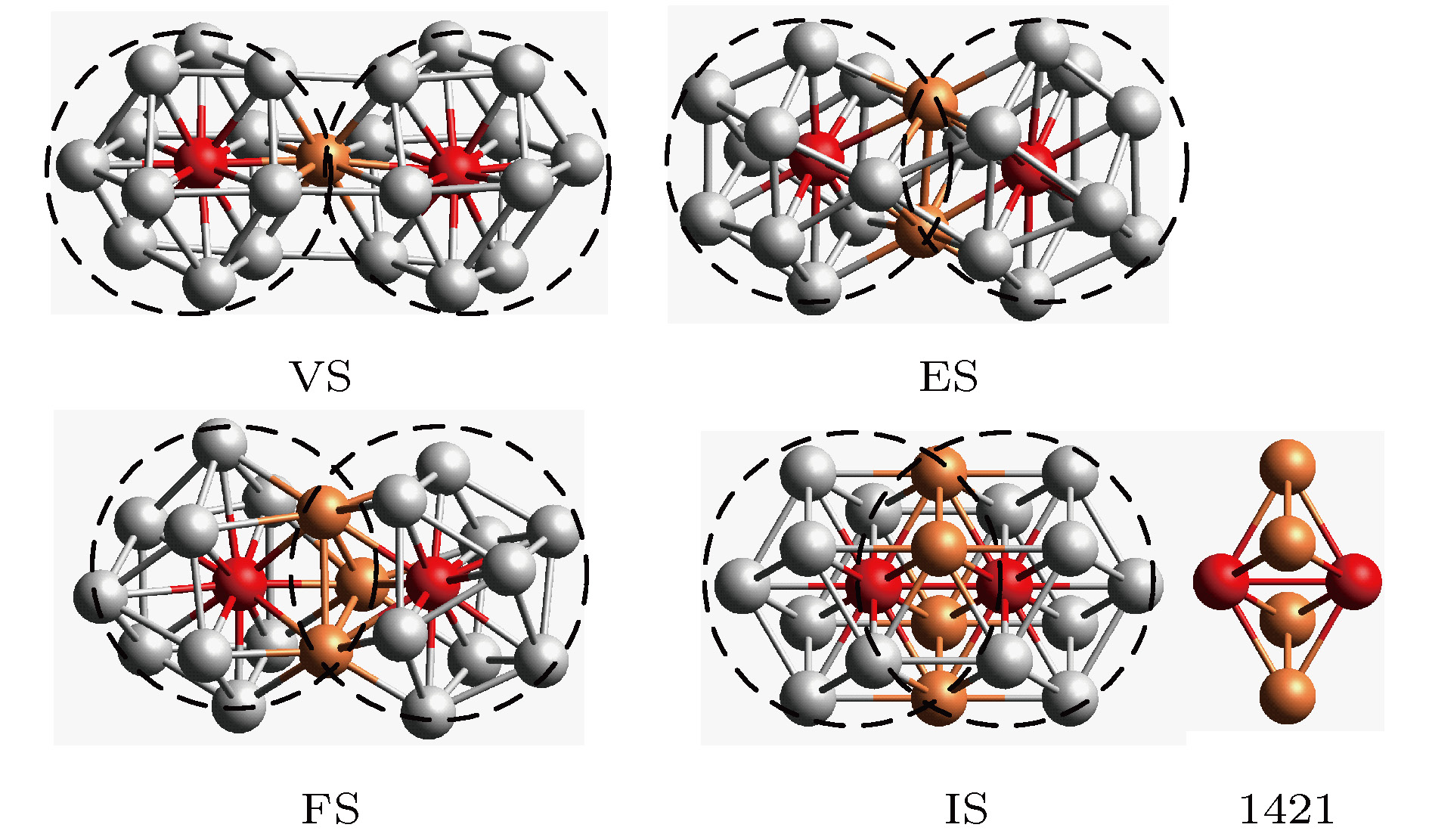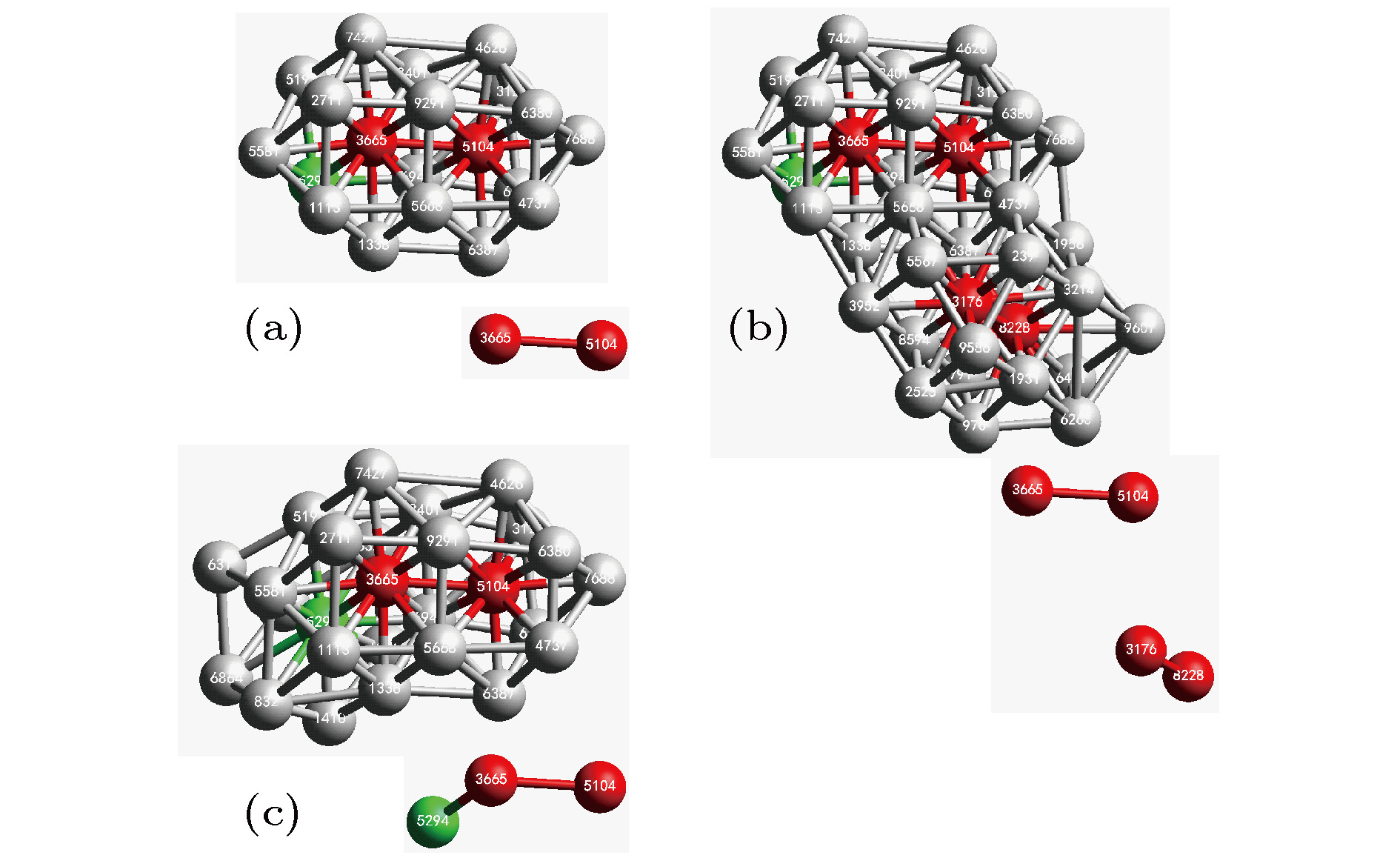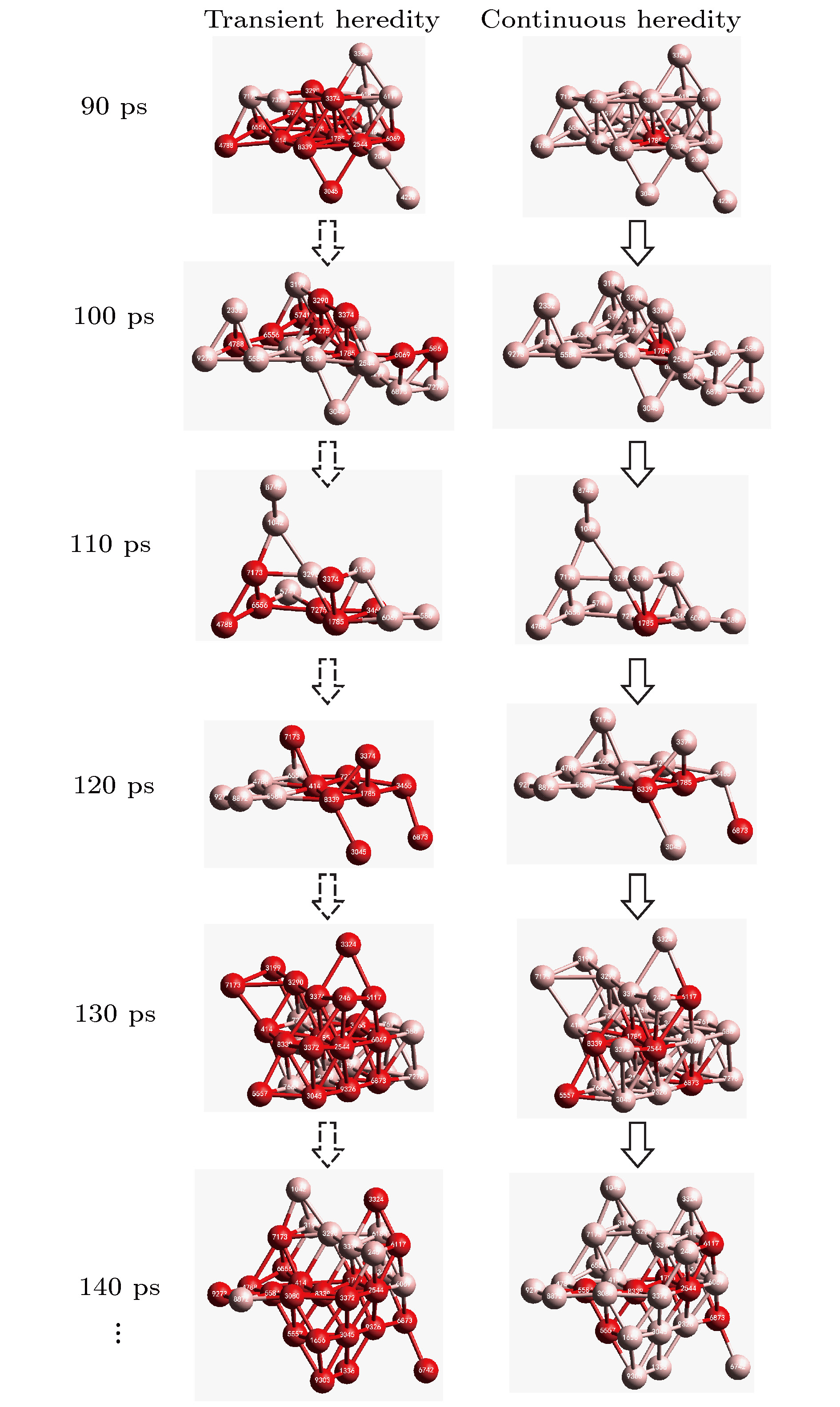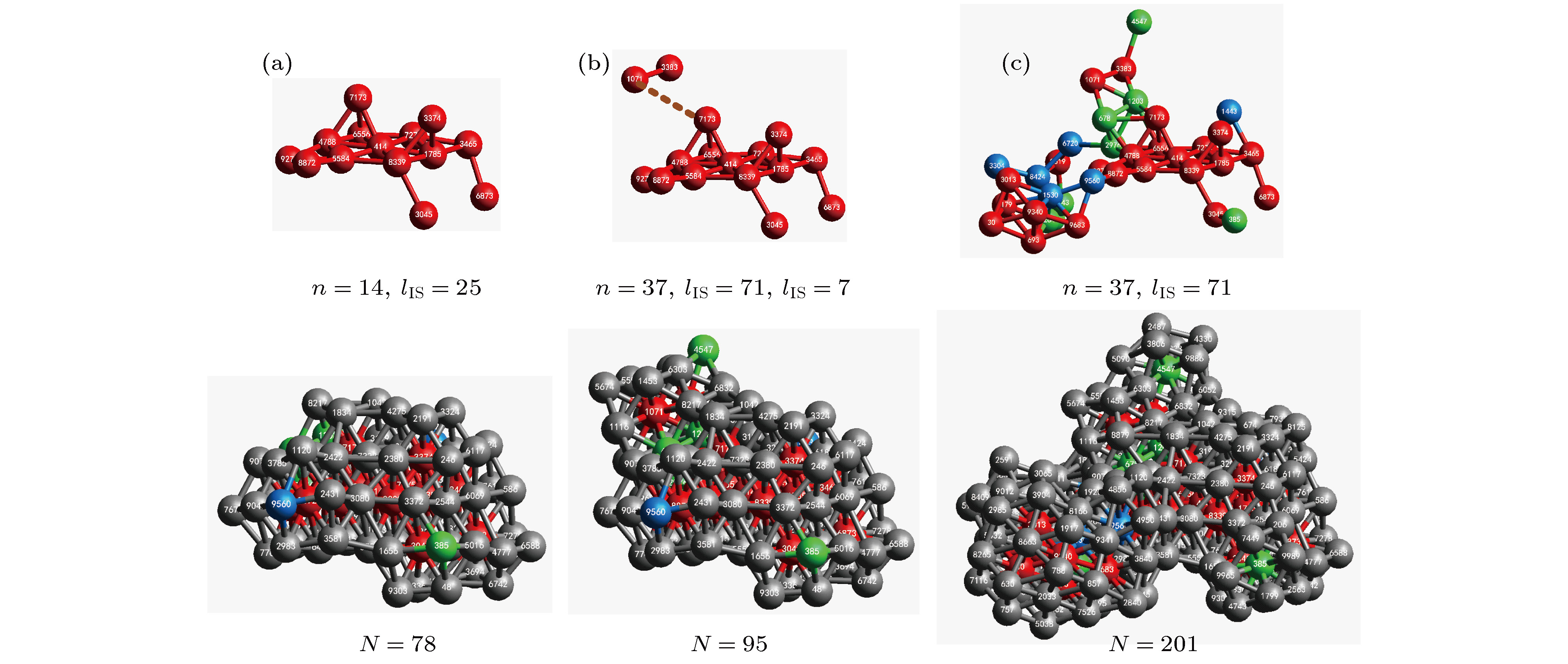-
采用分子动力学模拟研究了非晶Ag的等温晶化过程, 通过原子轨迹逆向追踪法分析了不同类型晶体团簇的结构遗传与组态演化. 在团簇类型指数法的基础上, 根据基本团簇种类与联结方式不同, 提出了一种可区分fcc单晶、多晶与混晶团簇的分析方法. 在非晶Ag等温晶化过程中, 基于团簇结构的连续遗传性特征, 发展了一种可区分fcc单晶、多晶与混晶晶胚与晶核的结构分析技术. 结果发现: 不论临界尺寸还是几何构型, 不同类型的晶核结构都存在差异, 其中fcc单晶临界尺寸最小, 多晶次之, 混晶最大; fcc单晶与多晶壳层原子中有少量hcp和bcc原子, 而混晶壳层则全部为非晶类原子, 并且fcc单晶、多晶与混晶的临界晶核都不是球型结构.The isothermal crystallization of amorphous Ag is investigated by a molecular dynamics (MD) simulation, and the heredity and evolution of different types of crystalline clusters aretracked and analyzed by a reverse tracking method of atom trajectories with the help of cluster-type index method (CTIM) based on Honeycutt-Anderson (H-A) bond-type index. According to the difference in the type of crystalline cluster and the linkage mode, i.e., vertex-sharing (VS), edge-sharing (ES), face-sharing (FS) and intercross-sharing (IS), a cluster analysis method which can efficiently characterize fcc single-crystal, fcc poly-crystal and fcc hydrid-crystal, is proposed. That is, the IS-linkage of fcc basic clusters, i.e., a fcc medium range order, is defined as a fcc single-crystal cluster. The extended cluster of fccbasic clusterslinked by ISand FS modes is named fcc poly-crystal clusters. In the case of IS-linkages, if the majority of core atoms arefcc atoms, the extended cluster composed of fcc, hcp and bcc basic clusters will be regarded as a fcc hydrid-crystal cluster. Moreover, a structural analysis method of critical nuclei distinguishing embryosis also developed in terms of the hereditary characteristics of various crystalline clusters. In this scheme, the extended cluster which has only transient heredity and no continuous heredity is defined as an embryo, while it will be named nuclei if part of core atoms in extended clusters can keep cluster type of atoms unchanged and be continuously passed down in the early stage of crystallization. Thus, corresponding to the onset time/temperature of continuous heredity, the critical nuclei of fcc singe-crystals, fcc poly-crystals and fcc hybrid-crystals can be identified and characterized. It is found that the nuclei of fcc crystalsemerge after the steep drop of total energy of system and before the abrupt increase of sizesof tracked clusters. And regardless of critical sizes or geometric configurations, an evident difference exists among fcc singe-crystal, hybrid-crystal clusters and fcc poly-crystal clusters, of which the fcc single-crystal nucleus is the smallest (~1.6 nm ×1.0 nm × 1.1 nm), followed by poly-crystal nucleus (~1.7 nm × 1.0 nm × 1.6 nm) and hydrid-crystal nucleus (~2.3 nm × 2.0 nm × 2.4 nm) in sequence. There are a few hcp and bcc atoms at surfaces, i.e. shells, of single-crystal and poly-crystal nucleus, but neither hcp nor bcc atom can be detected at the shell of fcc hydrid-crystal nucleus. And theconfiguration of fcc single-crystal, poly-crystal and hydrid-crystal critical nuclei are all non-spherical.
-
Keywords:
- nucleation /
- molecular dynamics simulation /
- cluster /
- critical nucleus
[1] Jiang Y H, Zou J T, Xiao P, Liang S H, Liu F, Gu B 2018 J. Non-Cryst. Solids 481 608
 Google Scholar
Google Scholar
[2] CelikA F, Kazanc S 2013 Physica B 63
[3] Hoang V V, Long N T, Son D N 2014 Comp. Mater. Sci. 95 491
 Google Scholar
Google Scholar
[4] Zhou K, Wang H P, Chang J, Wei B 2015 Chem. Phys. Lett. 639 105
 Google Scholar
Google Scholar
[5] Gasser U, Weeks E R, Schofield A, Pusey P N, Weitz D A 2001 Science 292 258
 Google Scholar
Google Scholar
[6] Lee B S, Burr G W, Shelby R M, Raoux S, Rettner C T, Bogle S N, Darmawikarta K, Bishop S G, Abelson J R 2009 Science 326 980
 Google Scholar
Google Scholar
[7] Lechner W, Dellago C 2008 J. Chem. Phys. 129 114707
 Google Scholar
Google Scholar
[8] Brostow W, Chybicki M, Laskowski R, Rybicki J 1998 Phys. Rev. B 57 13448
 Google Scholar
Google Scholar
[9] 文大东, 彭平, 蒋元祺, 田泽安, 刘让苏 2013 物理学报 62 196101
 Google Scholar
Google Scholar
Wen D D, Peng P, Jiang Y Q, Tian Z A, Liu R S 2013 Acta Phys. Sin. 62 196101
 Google Scholar
Google Scholar
[10] Kelton K F 1991 Solid. State. Phys. 45 75
 Google Scholar
Google Scholar
[11] Liu J, Zhao J Z, Hu Z Q 2007 Mat. Sci. Eng. A 452 103
[12] Honeycutt J D, Andersen H C 1987 J. Phys. Chem. 91 4950
 Google Scholar
Google Scholar
[13] Wu Z W, Li M Z, Wang W H, Song W J, Liu K X 2013 J. Chem. Phys. 138 620
[14] Li R, Wu Y, Xiao J 2014 J. Chem. Phys. 140 046102
[15] Zhou L L, Liu R S, Tian Z A, Liu H R, Hou Z Y, Peng P 2016 Sci. Rep. 6 31653
 Google Scholar
Google Scholar
[16] Yu D Q, Chen M, Yang H, Lü Y J 2009 Phil. Mag. Lett. 89 44
 Google Scholar
Google Scholar
[17] Zhang S L, Wang L M, Zhang X Y, Qi L, Zhang S H, Ma M Z, Liu R P 2015 Sci. Rep. 5 8590
 Google Scholar
Google Scholar
[18] Bai Y W, Bian X F, Qin J Y, Hu L N, Yang J F, Zhang K, Zhao X L, Zhang S, Huang Y Y, Yang C C 2014 J. Appl. Phys. 115 063106
 Google Scholar
Google Scholar
[19] Kalikmanov V I 2013 Nucleation Theory (Vol. 860)(Dordrecht: Springe) pp17-41
[20] Plimpton S 1995 Fast Parallel Algorithms for Short-range Molecular Dynamics (Academic Press Professional, Inc.) pp1−19
[21] Yang Z Y, Lu Z X, Zhao Y P 2009 Comp. Mater. Sci. 46 142
 Google Scholar
Google Scholar
[22] Lei Y W, Sun X R, Zhou R L, Bo Z 2018 Comp. Mater. Sci. 150 1
 Google Scholar
Google Scholar
[23] Foiles S M, Baskes M I, Daw M S 1986 Phys. Rev. B 33 7983
 Google Scholar
Google Scholar
[24] Martyna G J, Tobias D J, Klein M L 1994 J. Chem. Phys. 101 4177
 Google Scholar
Google Scholar
[25] Verlet L 1967 Health Phys. 22 79
[26] 邓永和, 文大东, 彭超, 韦彦丁, 赵瑞, 彭平 2016 物理学报 65 066401
 Google Scholar
Google Scholar
Deng Y H, Wen D D, Peng C, Wei Y D, Zhao R, Peng P 2016 Acta Phys. Sin. 65 066401
 Google Scholar
Google Scholar
[27] Zhou L L, Yang R Y, Tian Z A, Mo Y F, Liu R S 2017 J. Alloy. Compd. 690 633
 Google Scholar
Google Scholar
[28] Sun B, Sun Z W, Ouyang W Z, Xu S H 2014 J.Chem. Phys. 140 134904
 Google Scholar
Google Scholar
[29] Zhang H T, Mo Y F, Liu R S, Tian Z, Liu H R, Hou Z Y, Zhou L L, Liang Y C, Peng P 2018 Mater. Res. Express 5 036507
 Google Scholar
Google Scholar
[30] Hou Z Y, Liu L X, Liu R S, Tian Z A, Wang J G 2010 J. Appl. Phys. 107 629
[31] Lad K N, Jakse N, Pasturel A 2012 J. Chem. Phys. 136 3313
[32] Wen D D, Peng P, Jiang Y Q, Liu R S 2013 J. Non-Crys. Solids 378 61
 Google Scholar
Google Scholar
[33] Hou Z Y, Liu L X, Liu R S, Tian Z A, Wang J G 2010 Chem. Phys. Lett. 491 172
 Google Scholar
Google Scholar
[34] Wen D D, Peng P, Jiang Y Q, Tian Z A, Liu R S, Dong K J 2014 J. Non-Cryst. Solids 388 75
 Google Scholar
Google Scholar
[35] Streitz F H, Glosli J N, Patel M V 2006 Phys. Rev. Lett. 96 225701
 Google Scholar
Google Scholar
-
图 2 (a)典型晶体原子数目Ntotal随弛豫时间t的变化; (b)特征时间节点三类晶体原子的空间分布(红色、绿色和蓝色球分别表示fcc, hcp和bcc原子)
Fig. 2. (a) Variation of number Ntotal of various crystalline atoms with relaxation time t; (b) their spatial distributions at several special times, where red, green and blue balls represent fcc, hcp and bcc atoms, respectively.
图 4 三种fcc扩展晶体团簇及其芯部原子示意图(红色、绿色和灰色球分别表示fcc原子、hcp原子和其他表面原子, 芯原子间实线表示IS联结, 虚线表示FS联结) (a)单晶团簇; (b)多晶团簇; (c)混晶团簇
Fig. 4. Schematic diagram of three kinds of fcc extended clusters and their core atoms. Red, green and gray balls represent fcc, hcp, and other shell atoms, respectively. The solid line and dot line between core atoms represent IS-linkages and FS-linkages between fcc basic clusters, respectively. (a) Single-crystal cluster; (b) poly-crystal cluster; (c) hydrid-crystal cluster.
图 6 fcc单晶团簇芯原子的遗传与演化示意图. 左边为瞬态遗传, 右边为连续遗传, 深红色与浅红色球分别表示在两种遗传模式中可遗传和不具有遗传性的原子
Fig. 6. Schematic diagram of heredity and evolution of core atoms in the traced single-crystal cluster. Dark and light red balls represent heritable atoms and other atoms without heredity in transient and continuous heredities, respectively.
图 7 三种类型fcc临界晶核示意图 (a)单晶核; (b)多晶核; (c)混晶核(红色、绿色、蓝色和灰色球分别表示fcc, hcp, bcc和其他表面原子)
Fig. 7. Schematic diagram of critical crystalline nuclei and their core atoms. Red, green, blue and gray balls denote fcc, hcp, bcc and other shell atoms, respectively. (a) Single-crystal; (b) poly-crystal; (c) hydrid-crystal.
表 1 被追踪团簇在不同弛豫时间t的芯原子总数n(t)、可遗传至下一个时刻的原子数目ns(t)、可连续遗传的原子数目nc(t)及其中的IS和FS联结数lISc(t)和lFSc(t)
Table 1. The number of core atoms n(t), the number ns(t) and nc(t) of heritable core atoms in transient and continuous heredities at relaxation time t as well as the number lISc(t) and lFSc(t) of IS- and FS-linkages between heritable core atoms in the continuous heredity mode.
Single-crystal Poly-crystal Hydrid-crystal t/ps n ns nc lISc n ns nc lISc lFSc n ns nc lISc 200 53 55 134 190 38 31 31 82 41 31 31 82 0 117 56 56 116 180 38 25 22 38 39 25 22 38 0 66 42 33 52 170 36 19 13 20 36 19 13 20 0 78 27 17 21 160 36 24 11 15 39 24 11 15 0 69 35 13 15 150 27 20 8 8 28 20 8 8 1 52 26 9 8 140 30 21 7 7 30 21 7 7 1 70 34 8 7 130 30 18 6 5 30 18 6 5 1 65 34 6 5 120 14 9 3 1 16 9 3 1 1 37 11 3 1 110 14 7 1 0 17 7 1 0 0 29 11 1 0 100 22 9 1 0 24 9 1 0 0 37 13 1 0 90 21 13 1 0 23 13 1 0 0 52 20 1 0 80 18 12 1 0 20 12 1 0 0 35 16 1 0 70 27 11 1 0 31 13 1 0 0 41 18 1 0 60 22 7 1 0 24 7 1 0 0 32 9 1 0 50 18 9 1 0 18 9 1 0 0 20 10 1 0 40 13 7 0 0 13 7 0 0 0 14 7 0 0 30 2 1 0 0 7 2 0 0 0 11 2 0 0 -
[1] Jiang Y H, Zou J T, Xiao P, Liang S H, Liu F, Gu B 2018 J. Non-Cryst. Solids 481 608
 Google Scholar
Google Scholar
[2] CelikA F, Kazanc S 2013 Physica B 63
[3] Hoang V V, Long N T, Son D N 2014 Comp. Mater. Sci. 95 491
 Google Scholar
Google Scholar
[4] Zhou K, Wang H P, Chang J, Wei B 2015 Chem. Phys. Lett. 639 105
 Google Scholar
Google Scholar
[5] Gasser U, Weeks E R, Schofield A, Pusey P N, Weitz D A 2001 Science 292 258
 Google Scholar
Google Scholar
[6] Lee B S, Burr G W, Shelby R M, Raoux S, Rettner C T, Bogle S N, Darmawikarta K, Bishop S G, Abelson J R 2009 Science 326 980
 Google Scholar
Google Scholar
[7] Lechner W, Dellago C 2008 J. Chem. Phys. 129 114707
 Google Scholar
Google Scholar
[8] Brostow W, Chybicki M, Laskowski R, Rybicki J 1998 Phys. Rev. B 57 13448
 Google Scholar
Google Scholar
[9] 文大东, 彭平, 蒋元祺, 田泽安, 刘让苏 2013 物理学报 62 196101
 Google Scholar
Google Scholar
Wen D D, Peng P, Jiang Y Q, Tian Z A, Liu R S 2013 Acta Phys. Sin. 62 196101
 Google Scholar
Google Scholar
[10] Kelton K F 1991 Solid. State. Phys. 45 75
 Google Scholar
Google Scholar
[11] Liu J, Zhao J Z, Hu Z Q 2007 Mat. Sci. Eng. A 452 103
[12] Honeycutt J D, Andersen H C 1987 J. Phys. Chem. 91 4950
 Google Scholar
Google Scholar
[13] Wu Z W, Li M Z, Wang W H, Song W J, Liu K X 2013 J. Chem. Phys. 138 620
[14] Li R, Wu Y, Xiao J 2014 J. Chem. Phys. 140 046102
[15] Zhou L L, Liu R S, Tian Z A, Liu H R, Hou Z Y, Peng P 2016 Sci. Rep. 6 31653
 Google Scholar
Google Scholar
[16] Yu D Q, Chen M, Yang H, Lü Y J 2009 Phil. Mag. Lett. 89 44
 Google Scholar
Google Scholar
[17] Zhang S L, Wang L M, Zhang X Y, Qi L, Zhang S H, Ma M Z, Liu R P 2015 Sci. Rep. 5 8590
 Google Scholar
Google Scholar
[18] Bai Y W, Bian X F, Qin J Y, Hu L N, Yang J F, Zhang K, Zhao X L, Zhang S, Huang Y Y, Yang C C 2014 J. Appl. Phys. 115 063106
 Google Scholar
Google Scholar
[19] Kalikmanov V I 2013 Nucleation Theory (Vol. 860)(Dordrecht: Springe) pp17-41
[20] Plimpton S 1995 Fast Parallel Algorithms for Short-range Molecular Dynamics (Academic Press Professional, Inc.) pp1−19
[21] Yang Z Y, Lu Z X, Zhao Y P 2009 Comp. Mater. Sci. 46 142
 Google Scholar
Google Scholar
[22] Lei Y W, Sun X R, Zhou R L, Bo Z 2018 Comp. Mater. Sci. 150 1
 Google Scholar
Google Scholar
[23] Foiles S M, Baskes M I, Daw M S 1986 Phys. Rev. B 33 7983
 Google Scholar
Google Scholar
[24] Martyna G J, Tobias D J, Klein M L 1994 J. Chem. Phys. 101 4177
 Google Scholar
Google Scholar
[25] Verlet L 1967 Health Phys. 22 79
[26] 邓永和, 文大东, 彭超, 韦彦丁, 赵瑞, 彭平 2016 物理学报 65 066401
 Google Scholar
Google Scholar
Deng Y H, Wen D D, Peng C, Wei Y D, Zhao R, Peng P 2016 Acta Phys. Sin. 65 066401
 Google Scholar
Google Scholar
[27] Zhou L L, Yang R Y, Tian Z A, Mo Y F, Liu R S 2017 J. Alloy. Compd. 690 633
 Google Scholar
Google Scholar
[28] Sun B, Sun Z W, Ouyang W Z, Xu S H 2014 J.Chem. Phys. 140 134904
 Google Scholar
Google Scholar
[29] Zhang H T, Mo Y F, Liu R S, Tian Z, Liu H R, Hou Z Y, Zhou L L, Liang Y C, Peng P 2018 Mater. Res. Express 5 036507
 Google Scholar
Google Scholar
[30] Hou Z Y, Liu L X, Liu R S, Tian Z A, Wang J G 2010 J. Appl. Phys. 107 629
[31] Lad K N, Jakse N, Pasturel A 2012 J. Chem. Phys. 136 3313
[32] Wen D D, Peng P, Jiang Y Q, Liu R S 2013 J. Non-Crys. Solids 378 61
 Google Scholar
Google Scholar
[33] Hou Z Y, Liu L X, Liu R S, Tian Z A, Wang J G 2010 Chem. Phys. Lett. 491 172
 Google Scholar
Google Scholar
[34] Wen D D, Peng P, Jiang Y Q, Tian Z A, Liu R S, Dong K J 2014 J. Non-Cryst. Solids 388 75
 Google Scholar
Google Scholar
[35] Streitz F H, Glosli J N, Patel M V 2006 Phys. Rev. Lett. 96 225701
 Google Scholar
Google Scholar
计量
- 文章访问数: 8256
- PDF下载量: 64
- 被引次数: 0














 下载:
下载:






